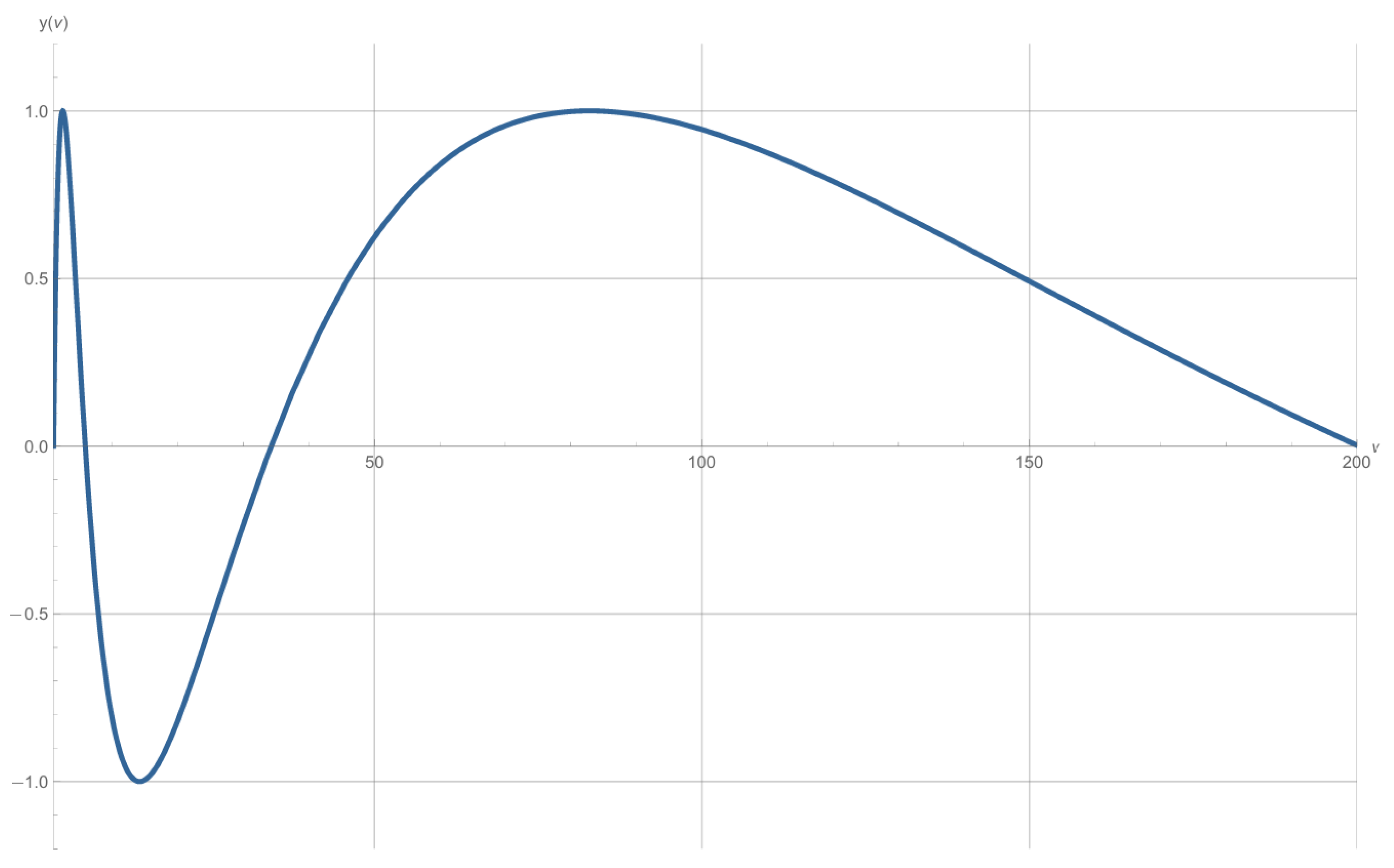Oscillation Theorems of Fourth-Order Differential Equations with a Variable Argument Using the Comparison Technique
Abstract
1. Introduction
- (H1)
- , , and
- (H2)
- , , , and
- (H3)
- , for , and where (positive real numbers).
2. Main Results
- (N1)
- and , where .
- (N2)
- for .
2.1. Auxiliary Lemmas
2.2. Oscillation Criterion
- (i)
- (N1) holds and
- (ii)
- (N2) holds and
2.3. Further Oscillation Results
2.4. Examples and Comparison
3. Conclusions
Author Contributions
Funding
Data Availability Statement
Acknowledgments
Conflicts of Interest
Correction Statement
References
- Gyori, I.; Ladas, G.E. Oscillation Theory of Delay Differential Equations: With Applications; The Clarenden Press: Oxford, UK, 1992; Available online: https://ci.nii.ac.jp/ncid/BA12864725 (accessed on 22 June 2025).
- Agarwal, R.P.; Grace, S.R.; O’Regan, D. Oscillation Theory for Second Order Linear, Half-Linear, Superlinear and Sublinear Dynamic Equations; Kluwer Academic Publishers: Dordrecht, The Netherlands, 2002. [Google Scholar] [CrossRef]
- Došlý, O.; Řehák, P. Half-Linear Differential Equations; Elsevier: Amsterdam, The Netherlands, 2005; Available online: http://www.gbv.de/dms/goettingen/486895475.pdf (accessed on 1 May 2022).
- Dorf, R.C.; Svoboda, J.A. Introduction to Electric Circuits; John Wiley & Sons: Hoboken, NJ, USA, 2010. [Google Scholar]
- Murray, J.D. Mathematical Biology: I. An Introduction; Springer Science & Business Media: Berlin/Heidelberg, Germany, 2007. [Google Scholar]
- Dahiya, R.S.; Singh, B. On oscillatory behavior of even order delay equations. J. Math. Anal. Appl. 1973, 42, 183–190. [Google Scholar] [CrossRef]
- Grace, S.R.; Lalli, B.S. Oscillation theorems for nth-order delay differential equations. J. Math. Anal. Appl. 1983, 91, 352–366. [Google Scholar] [CrossRef]
- Grace, S.R. Oscillation of even order nonlinear functional differential equations with deviating arguments. Math. Slovaca 1991, 41, 189–204. Available online: https://eudml.org/doc/34314 (accessed on 22 May 2022).
- Zafer, A. Oscillation criteria for even order neutral differential equations. Appl. Math. Lett. 1998, 11, 21–25. [Google Scholar] [CrossRef]
- Agarwal, R.P.; Bohner, M.; Li, T.; Zhang, C. A new approach in the study of oscillatory behavior of even-order neutral delay differential equations. Appl. Math. Comput. 2013, 225, 787–794. [Google Scholar] [CrossRef]
- Zhang, Q.; Yan, J. Oscillation behavior of even order neutral differential equations with variable coefficients. Appl. Math. Lett. 2006, 19, 1202–1206. [Google Scholar] [CrossRef]
- Agarwal, R.P.; Grace, S.R. Oscillation theorems for certain functional differential equations of higher order. Math. Comput. Model. 2004, 39, 1185–1194. [Google Scholar] [CrossRef]
- Agarwal, R.P.; Grace, S.R.; O’Regan, D. Oscillation Theory for Difference and Functional Differential Equations; Springer: Dordrecht, The Netherlands, 2000. [Google Scholar] [CrossRef]
- Kusano, T.; Naito, M. Comparison theorems for functional-differential equations with deviating arguments. J. Math. Soc. Jpn. 1981, 33, 509–532. [Google Scholar] [CrossRef]
- Agarwal, R.P.; Shieh, S.-L.; Yeh, C.-C. Oscillation criteria for second-order retarded differential equations. Math. Comput. Model. 1997, 26, 1–11. [Google Scholar] [CrossRef]
- Wong, P.J.Y.; Agarwal, R.P. Oscillation theorems and existence criteria of asymptotically monotone solutions for second order differential equations. Dyn. Syst. Appl. 1995, 4, 477–496. [Google Scholar]
- Jadlovská, I.; Džurina, J. Kneser-type oscillation criteria for second-order half-linear delay differential equations. Appl. Math. Comput. 2020, 380, 125289. [Google Scholar] [CrossRef]
- Philos, C.G. On the existence of nonoscillatory solutions tending to zero at ∞ for differential equations with positive delays. Arch. Math. 1981, 36, 168–178. [Google Scholar] [CrossRef]
- Erbe, L.H.; Kong, Q.; Zhang, B.G. Oscillation Theory for Functional Differential Equations; Marcel Dekker, Inc.: New York, NY, USA, 1995. [Google Scholar] [CrossRef]
- Grace, S.R.; Lalli, B.S. Oscillation Theorems for nth Order Nonlinear Differential Equations with Deviating Arguments. Proc. Am. Math. Soc. 1984, 90, 65. [Google Scholar] [CrossRef]
- Zhang, Q.; Yan, J.; Gao, L. Oscillation behavior of even-order nonlinear neutral differential equations with variable coefficients. Comput. Math. Appl. 2009, 59, 426–430. [Google Scholar] [CrossRef]
- Koplatadze, R.; Kvinikadze, G.; Stavroulakis, I.P. Properties A and B of nth order linear differential equations with deviating argument. Georgian Math. J. 1999, 6, 553–566. [Google Scholar] [CrossRef]

Disclaimer/Publisher’s Note: The statements, opinions and data contained in all publications are solely those of the individual author(s) and contributor(s) and not of MDPI and/or the editor(s). MDPI and/or the editor(s) disclaim responsibility for any injury to people or property resulting from any ideas, methods, instructions or products referred to in the content. |
© 2025 by the authors. Licensee MDPI, Basel, Switzerland. This article is an open access article distributed under the terms and conditions of the Creative Commons Attribution (CC BY) license (https://creativecommons.org/licenses/by/4.0/).
Share and Cite
Moaaz, O.; Albalawi, W.; Alotaibi, R. Oscillation Theorems of Fourth-Order Differential Equations with a Variable Argument Using the Comparison Technique. Axioms 2025, 14, 587. https://doi.org/10.3390/axioms14080587
Moaaz O, Albalawi W, Alotaibi R. Oscillation Theorems of Fourth-Order Differential Equations with a Variable Argument Using the Comparison Technique. Axioms. 2025; 14(8):587. https://doi.org/10.3390/axioms14080587
Chicago/Turabian StyleMoaaz, Osama, Wedad Albalawi, and Refah Alotaibi. 2025. "Oscillation Theorems of Fourth-Order Differential Equations with a Variable Argument Using the Comparison Technique" Axioms 14, no. 8: 587. https://doi.org/10.3390/axioms14080587
APA StyleMoaaz, O., Albalawi, W., & Alotaibi, R. (2025). Oscillation Theorems of Fourth-Order Differential Equations with a Variable Argument Using the Comparison Technique. Axioms, 14(8), 587. https://doi.org/10.3390/axioms14080587







